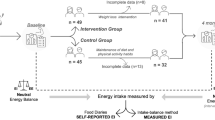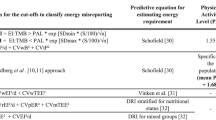Abstract
Objective:
Although under-reporting of dietary intake is more common in persons with a high body mass index (BMI), it is not well known whether or not misreporting is selective for different foods (and hence energy and nutrients), particularly in non-Western populations. We examined misreporting of dietary intake against biomarkers and its relation with BMI in young Japanese women.
Design:
Cross-sectional study.
Subjects:
A total of 353 female Japanese dietetic students aged 18–22 years (mean BMI: 21.4 kg/m2, mean fat intake: 29.8% of energy).
Methods:
Misreporting of dietary energy, protein, potassium and sodium (assessed by a self-administered diet history questionnaire) was examined against respective biomarkers (estimated energy expenditure and 24-h urinary excretion). Reporting accuracy was calculated as the ratio of reported intake to that estimated from corresponding biomarkers (complete accuracy: 1.00).
Results:
Mean reporting accuracy of absolute intake (amount per day) varied considerably (0.86–1.14). Reporting accuracy of absolute intake decreased with increasing BMI (P for trend <0.001). However, no association was observed between reporting accuracy of energy-adjusted values and BMI (P for trend >0.15), indicating that BMI-dependent misreporting was canceled by energy adjustment. This was owing to positive correlation between the reporting accuracy of energy intake and that of absolute intake of the three nutrients (Pearson correlation coefficient: 0.49–0.67, P<0.0001).
Conclusions:
Although differential misreporting of absolute intake was associated with BMI, differential misreporting of energy-adjusted value was not. These findings support the use of energy-adjusted values in the investigation of diet–disease relationships among lean populations with a low-fat intake.
This is a preview of subscription content, access via your institution
Access options
Subscribe to this journal
Receive 12 print issues and online access
$259.00 per year
only $21.58 per issue
Buy this article
- Purchase on Springer Link
- Instant access to full article PDF
Prices may be subject to local taxes which are calculated during checkout
Similar content being viewed by others
References
Ard JD, Desmond RA, Allison DB, Conway JM (2006). Dietary restraint and disinhibition do not affect accuracy of 24-hour recall in a multiethnic population. J Am Diet Assoc 106, 434–437.
Bingham S, Cummings JH (1983). The use of 4-aminobenzoic acid as a marker to validate the completeness of 24 h urine collections in man. Clin Sci 64, 629–635.
Bingham SA (2003). Urine nitrogen as a biomarker for the validation of dietary protein intake. J Nutr 133, 921S–924S.
Bingham SA, Cassidy A, Cole TJ, Welch A, Runswick SA, Black AE et al. (1995). Validation of weighed records and other methods of dietary assessment using the 24 h urine nitrogen technique and other biological markers. Br J Nutr 73, 531–550.
Bingham SA, Cummings JH (1985). Urine nitrogen as an independent validatory measure of dietary intake: a study of nitrogen balance in individuals consuming their normal diet. Am J Clin Nutr 42, 1276–1289.
Black AE, Bingham SA, Johansson G, Coward WA (1997). Validation of dietary intakes of protein and energy against 24 h urinary N and DLW energy expenditure in middle-aged women, retired men and post-obese subjects: comparisons with validation against presumed energy requirements. Eur J Clin Nutr 51, 405–413.
Black AE, Coward WA, Cole TJ, Prentice AM (1996). Human energy expenditure in affluent societies: an analysis of 574 doubly-labelled water measurements. Eur J Clin Nutr 50, 72–92.
Black AE, Welch AA, Bingham SA (2000). Validation of dietary intakes measured by diet history against 24 h urinary nitrogen excretion and energy expenditure measured by the doubly-labelled water method in middle-aged women. Br J Nutr 83, 341–354.
Conway JM, Ingwersen LA, Moshfegh AJ (2004). Accuracy of dietary recall using the USDA five-step multiple-pass method in men: An observational validation study. J Am Diet Assoc 104, 595–603.
Conway JM, Ingwersen LA, Vinyard BT, Moshfegh AJ (2003). Effectiveness of the US Department of Agriculture 5-step multiple-pass method in assessing food intake in obese and nonobese women. Am J Clin Nutr 77, 1171–1178.
FAO/WHO/UNU (1985). Energy and protein requirements. Report of a joint FAO/WHO/UNU Expert Consultation, Technical Report Series 724. World Health Organization: Geneva.
Freedman LS, Midthune D, Carroll RJ, Krebs-Smith S, Subar AF, Troiano RP et al. (2004). Adjustments to improve the estimation of usual dietary intake distributions in the population. J Nutr 134, 1836–1843.
Heerstrass DW, Ocke MC, Bueno-de-Mesquita HB, Peeters PH, Seidell JC (1998). Under-reporting of energy, protein and potassium intake in relation to body mass index. Int J Epidemiol 27, 186–193.
Heitmann BL, Lissner L (1995). Dietary under-reporting by obese individuals: is it specific or non-specific? Br Med J 311, 986–989.
Heitmann BL, Lissner L (2005). Can adverse effects of dietary fat intake be overestimated as a consequence of dietary fat under-reporting? Public Health Nutr 8, 1322–1327.
Heitmann BL, Lissner L, Osler M (2000). Do we eat less fat, or just report so? Int J Obes Relat Metab Disord 24, 435–442.
Holbrook JT, Patterson KY, Bodner JE, Douglas LW, Veillon C, Kelsay JL et al. (1984). Sodium and potassium intake and balance in adults consuming self-selected diets. Am J Clin Nutr 40, 786–793.
Hulten B, Bengtsson C, Isaksson B (1990). Some errors inherent in a longitudinal dietary survey revealed by the urine nitrogen test. Eur J Clin Nutr 44, 169–174.
Kipnis V, Midthune D, Freedman LS, Bingham S, Schatzkin A, Subar A et al. (2001). Empirical evidence of correlated biases in dietary assessment instruments and its implications. Am J Epidemiol 153, 394–403.
Larsson CL, Johansson GK (2002). Dietary intake and nutritional status of young vegans and omnivores in Sweden. Am J Clin Nutr 76, 100–106.
Lissner L (2002). New approaches to assessing diets of diverse populations. Measuring food intake in studies of obesity. Public Health Nutr 5, 889–892.
Livingstone MBE, Black AE (2003). Markers of the validity of reported energy intake. J Nutr 133, 895S–920S.
Mahabir S, Baer DJ, Giffen C, Subar A, Campbell W, Hartman TJ et al. (2006). Calorie intake misreporting by diet record and food frequency questionnaire compared to doubly labeled water among postmenopausal women. Eur J Clin Nutr 60, 561–565.
Mattisson I, Wirfalt E, Aronsson CA, Wallstrom P, Sonestedt E, Gullberg B et al. (2005). Misreporting of energy: prevalence, characteristics of misreporters and influence on observed risk estimates in the Malmo Diet and Cancer cohort. Br J Nutr 94, 832–842.
Ministry of Health, Labour, and Welfare (2006). The National Health and Nutrition Survey in Japan, 2003. Ministry of Health and Welfare (in Japanese): Tokyo.
Paul DR, Rhodes DG, Kramer M, Baer DJ, Rumpler WV (2005). Validation of a food frequency questionnaire by direct measurement of habitual ad libitum food intake. Am J Epidemiol 162, 806–814.
Poppitt SD, Swann D, Black AE, Prentice AM (1998). Assessment of selective under-reporting of food intake by both obese and non-obese women in a metabolic facility. Int J Obes Relat Metab Disord 22, 303–311.
Rosell MS, Hellenius MLB, De Faire UH, Johansson GK (2003). Associations between diet and the metabolic syndrome vary with the validity of dietary intake data. Am J Clin Nutr 78, 84–90.
Sasaki S, Ushio F, Amano K, Morihara M, Todoriki T, Uehara Y et al. (2000). Serum biomarker-based validation of a self-administered diet history questionnaire for Japanese subjects. J Nutr Sci Vitaminol 46, 285–296.
Sasaki S, Yanagibori R, Amano K (1998a). Self-administered diet history questionnaire developed for health education: a relative validation of the test-version by comparison with 3-day diet record in women. J Epidemiol 8, 203–215.
Sasaki S, Yanagibori R, Amano K (1998b). Validity of a self-administered diet history questionnaire for assessment of sodium and potassium: comparison with single 24-hour urinary excretion. Jpn Circ J 62, 431–435.
Science and Technology Agency (2000). Standard Tables of Food Composition in Japan 5th ed. Printing Bureau of the Ministry of Finance (in Japanese): Tokyo.
Stamler J, Elliott P, Dennis B, Dyer AR, Kesteloot H, Liu K et al. (2003). INTERMAP: background, aims, design, methods, and descriptive statistics (nondietary). J Human Hypertens 17, 591–608.
Subar AF, Kipnis V, Troiano RP, Midthune D, Schoeller DA, Bingham S et al. (2003). Using intake biomarkers to evaluate the extent of dietary misreporting in a large sample of adults: the OPEN Study. Am J Epidemiol 158, 1–13.
Tasevska N, Runswick SA, Bingham SA (2006). Urinary potassium is as reliable as urinary nitrogen for use as a recovery biomarker in dietary studies of free living individuals. J Nutr 136, 1334–1340.
Tooze JA, Subar AF, Thompson FE, Troiano R, Schatzkin A, Kipnis V (2004). Psychosocial predictors of energy under reporting in a large doubly labeled water study. Am J Clin Nutr 79, 795–804.
WHO Regional Office for Europe (1984). Estimation of sodium intake and output: review of methods and recommendations for epidemiological studies. Report on a WHO meeting by the WHO collaborating center for research and training in cardiovascular diseases. World Health Organization: Geneva.
Willett W (1998). Nutritional Epidemiology 2nd ed. Oxford University Press: New York.
Yamamura C, Kashiwazaki H (2002). Factors affecting the post-absorptive resting metabolic rate of Japanese subjects: reanalysis based on published data. Jpn J Nutr Diet 60, 75–83. (in Japanese with English abstract).
Zhang J, Temme EHM, Sasaki S, Kesteloot H (2000). Under- and over-reporting of energy intake using urinary cations as biomarkers: relation to body mass index. Am J Epidemiol 152, 453–462.
Acknowledgements
We thank Yuko Hisatomi, Junko Soezima and Kazumi Takedomi (Nishikyushu University), Yoko Umeki (Fukuoka Women's University), Yoko Ichikawa (University of Shizuoka), Tomoko Ide (Tokyo Kasei University), Maiko Suzuki (Mie Chukyo University Junior College), Etsuko Uneoka (Otemae College of Nutrition), Kanako Muramatsu (Niigata Women's College) and Mika Furuki (Minamikyushu University) for data collection.
Author information
Authors and Affiliations
Corresponding author
Additional information
Guarantor: S Sasaki.
Contributors: KM contributed to the concept and design of the study, the study protocol, data collection and management; and coordinated the field work, formulated the hypothesis, analyzed and interpreted the data, and wrote the manuscript. SS was responsible for the concept and design of the study, the study protocol, data collection and management; and interpreted the results and contributed to the writing and editing of the manuscript. YT contributed to the writing and editing of the manuscript. KU contributed to the concept and design of the study, the study protocol, and data collection. MY, HH, TG, JO, KB, KO, TK, RW, and YS contributed to data collection. All authors contributed to the final version of the manuscript.
Rights and permissions
About this article
Cite this article
Murakami, K., Sasaki, S., Takahashi, Y. et al. Misreporting of dietary energy, protein, potassium and sodium in relation to body mass index in young Japanese women. Eur J Clin Nutr 62, 111–118 (2008). https://doi.org/10.1038/sj.ejcn.1602683
Received:
Revised:
Accepted:
Published:
Issue Date:
DOI: https://doi.org/10.1038/sj.ejcn.1602683
Keywords
This article is cited by
-
Relationship between vitamin D receptor gene polymorphisms (BsmI, TaqI, ApaI, and FokI) and calcium intake on bone mass in young Japanese women
BMC Women's Health (2021)
-
Impact of dietary counseling on the perception of diet in patients with gestational diabetes mellitus
Diabetology International (2021)
-
Body mass index modifies the association between frequency of alcohol consumption and incidence of hypertension in men but not in women: a retrospective cohort study
Hypertension Research (2020)
-
Impact of body mass index and age on the relative accuracy of self-reported energy intakes among Japanese patients with type 2 diabetes
Diabetology International (2020)
-
Comparison of a salt check sheet with 24-h urinary salt excretion measurement in local residents
Hypertension Research (2016)



